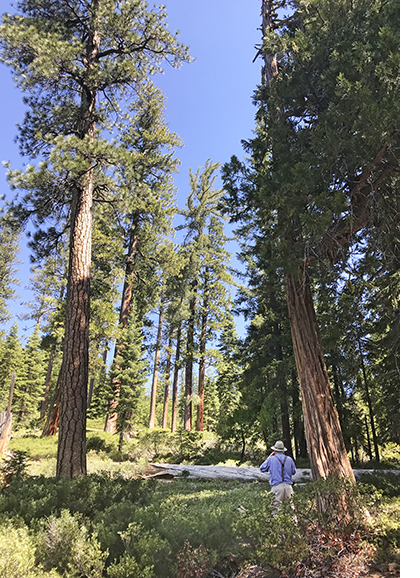Forest Flash:
Wildlife and Water; Celebrating Community; New Partnerships for Forests
In Pacific Forest Trust’s e-newsletter, Forest Flash, we send you the most recent PFT news and updates on forests, clean water, climate, and wildlife, no more than once or twice a month. Subscribe here.
Protecting California’s Wildlife Heritage—
Climate Smart Biodiversity Planning

The 7-million-acre Sacramento River Headwaters Region and its surrounding 3-million- acre buffer zone, has an extraordinarily important role for biodiversity as well as water supply in California. Delineated by three mountain ranges (the northern Sierra, southern Cascade, and Klamath-Trinity), its varied topography, soils, and geology support an extraordinarily wide variety of plants and habitats. The region contains over 80% of California’s natural habitat types and hosts over 60% of its vertebrate species; in fact, it is one of 33 globally recognized biodiversity “hot spots”. With such a major role in supporting California’s biodiversity, we wanted to see how it would fare under intensifying climate change. In a project funded by California’s Wildlife Conservation Board, we, with leading climate scientist James Thorne, Ph.D., and Ryan Boynton of University of California, Davis, and landscape ecologist Dean Urban Ph.D. of Duke University, we assessed how persistent this habitat might be over the next 100 years. Watch “Climate Smart Biodiversity Conservation in California: A Model Approach”.
While the overall impact of climate change projected under our present trajectory is a grim picture, the analysis showed that this region is noticeably less impacted by climate change than many others in the state, and its importance for biodiversity conservation was underscored. It also illustrated ways in which our actions in the nearer term can change that trajectory, also buffering the likely impacts of climate change. Importantly, we identified that the region will likely support almost 5 million acres of consensus refugia, with an additional 1.5 million acres of probable or possible refugia under moderate stress, by 2040. A clear focus on conserving and restoring the private ownerships in these areas, as well as a focus on restoration in the public lands therein, will greatly enhance the likelihood of habitat persistence and species survival. Learn more about this study and its results.
We’re Having a Party…Come join the fun!
On April 29th, from 6:30-7:30 PM Pacific Time, we are hosting our Annual Forest Fete. This year’s Fete, Renewing the Fabric of Forests and Communities, will be a virtual celebration, one which all can join. Pacific Forest Trust’s largest annual gathering, it’s a time to be inspired, engaged, and build our sense of community, while celebrating PFT’s innovative achievements and partnerships. This year, we are thrilled to be joined by two very special guests, the renowned musical artists, Jackson Browne and Dan “Lebo” Lebowitz. We are delighted to honor Randy Moore, Pacific Southwest Regional Forester this year with our “Outside the Box” award for his leadership in managing federal forests for their multiple climate, water, and wildlife benefits, while also leading the way in managing fire. We hope you will join us for an enriching hour of conversation, compelling storytelling, inspiring speakers, and much more! Learn more about Fete 2021, how to register, donate or sponsor the event.
Conserving the source for the Central Valley Project, Trinity and Lewiston Lakes

PFT has entered into an exciting and unusual partnership to conserve a critical, large ownership in the Upper Trinity watershed. Working with a willing landowner, MichiCal Timber Company, PFT has agreed to conserve 11,000 acres — 9% — of this watershed, and then convey it to The Watershed Research and Training Center in Trinity County to be managed to benefit both ecological and human communities.
The Upper Trinity Watershed (one of the 5 key source watersheds in the state) is both exceptionally biodiverse and water-rich. It feeds Trinity Lake, with a capacity of 2,400,000 acre-feet, making it the 3rd largest reservoir in the state, and then flows to the Lewiston Lake and thence is tunneled into the Sacramento River. Outstandingly diverse, with a high probability of habitat persistence under climate change, the Trinity Headwaters project is a unique opportunity to show how we can protect valuable forests while supporting restoration jobs and community identity. Protecting this property’s especially valuable mid-elevation wet meadows directly benefits the listed Cascade, Pacific tailed, and Foothill yellow frogs. There are also rare old-growth forests and old-forest dependent species, like the Spotted Owl.
“The Watershed Center has collaborated with Pacific Forest Trust on a number of issues over time. We are really pleased to be working with PFT on this exciting project. Their partnership will allow us to fulfill a long-term goal for WTRC of managing and restoring this forest in our own backyard.”— Nick Goulette, Executive Director of the Watershed Center

The Trinity Headwaters provides critical safe haven for vulnerable and listed species such as the Cascades Frog, found in these higher elevation ponds, meadows, and streams
The property is highly visible from the Pacific Crest Trail, and lies adjacent to it in sections. From recreation, to water, wildlife and community engagement, this project has multiple public benefits. Our project will support both restoration and future sustainable forest management while also providing myriad other positive outcomes related to the long-term ecosystem and rural community health.
Learn more about how this fits into PFT’s goal to restore and maintain the critical source watersheds of California.

